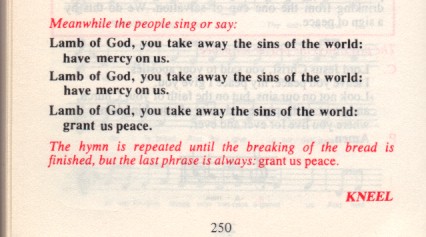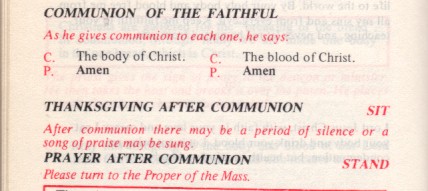Changed laws in 2002 Roman Missal on this
Journal
0957 L Tue 29 Jan 2002
At Mass, after the Lamb of God, should the people remain standing or kneel?
According to the 1975 General Instruction to the Roman Missal they should remain standing:
21. For the sake of uniformity in movement and posture, the people should follow the directions given during the celebration by the deacon, priest, or another minister. Unless other provision is made, at every Mass the people should stand ... from the prayer over the gifts to the end of the Mass, except ... They should sit ... if this seems helpful, during the period of silence after communion. They should kneel at the consecration unless prevented by the lack of space, the number of people present, or some other good reason.
However in the same paragraph there is the following instruction:
But it is up to the conference of bishops to adapt the actions and postures described in the Order of the Roman Mass to the customs of the people.
The 2000 edition of the General Instruction to the Roman Missal says much the same thing in n. 43. But it emphasises that the adaptations should be "according to the norm of law" and directions given should be "according to whatever is indicated in the liturgical books."
How adaptations is to be done is made clear in the 1994 document "The Roman Liturgy and Inculturation", published by the Congregation for Divine Worship and the Discipline of the Sacraments:
Procedure to follow when making the adaptions provided for in liturgical books
62. When an Episcopal Conference prepares its own edition of liturgical books, it decides about the translations and also the adaptations which are envisaged by the law. The acts of the Conference, together with the final vote, are signed by the President and Secretary of the Conference and sent to the Congregation for Divine Worship and the Discipline of the Sacraments, along with two copies of the approved text.
Moreover along with the complete dossier should be sent:
a) a succinct and precise explanation of the reasons for the adaptations that have been introduced;
b) indications as to which sections have been taken from other already approved liturgical books and which are newly composed.
After the "recognition" by the Apostolic See has been received, according to the law, (Cf. Code of Canon Law, can. 838.3) the Episcopal Conference promulgates the Decree and determines the date when the new text comes into force.
This is following the 1983 Code of Canon Law:
838.3 It pertains to Bishop's Conferences to prepare vernacular translations of liturgical books, with the appropriate adaptations as allowed by the books themselves and, with the prior review of the Holy See, to publish these translations.
So if the bishops want the people to kneel after the Lamb of God this adaptation should be included in the translation reviewed by the Holy See.
In the United States the Bishops Committee for the Liturgy has indicated that no such adaptation has been approved. However Helen Hull Hitchcock of www.adoremus.org claimed in September 2000 that this contradicts earlier instructions:
However, the BCL's statement above contradicts its own rulings published in 1966 and 1969 (and never withdrawn) which explicitly directed that the people are to kneel at the customary places, after the Agnus Dei and after receiving Holy Communion.
In Australia the situation is less clear. On Sunday I bought "The Order of Mass with a Congregation", published December 2001 (ISBN 1-876295-44-9), with the Imprimatur of Bishop Manning of Paramatta. It is "Approved for use in Australia by the Bishops' Committee for Liturgy". But there are hardly any instructions on posture. For the first reading "All sit and listen." But that is the only instruction on posture for the people I can find. It does not say to stand at the Alleluia, nor does it have anything for after the Lamb of God.
In the Daily Mass Book (E.J. Dwyer, ISBN 0 85574 289 5, Sydney, 1975) there are simple instructions. After the Lamb of God it has "KNEEL", for the Thanksgiving After Communion "SIT", and for the Prayer After Communion "STAND".


A 1985 hymn book "Catholic Worship Book" (ISBN 0 00 599836 0) also has "Kneel" after the Lamb of God in 527.
Such instructions are clear and simple. So why were they not included in later books? For example they are absent in the 1982 book The Sunday Missal, (ISBN 0 00 599718 6) and the 2001 publication. It seems to me because they are not legitimately approved adaptations.
According to Canon 846 "The liturgical books, approved by the competent authority are to be faithfully followed." So my judgement is to follow the 1975 Roman Missal and stand after the Lamb of God.
Hopefully this will be clarified soon with the publication of the Third Edition of the Roman Missal and an approved Australian translation with adaptations.
Copyright J.R. Lilburne, 29 January 2002. Last updated 8 April 2002.
Links to other sites:
